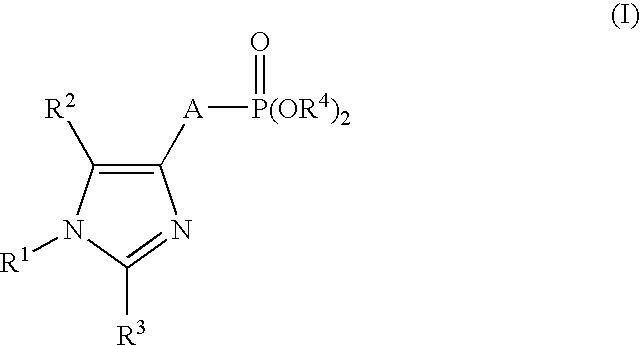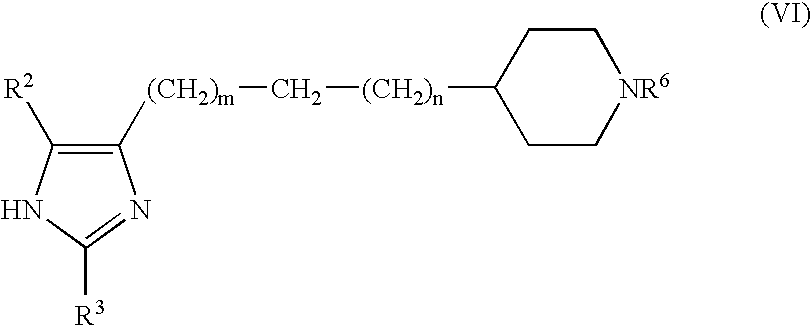Production of imidazole derivatives and novel intermediates of the derivatives
a technology of imidazole and derivatives, applied in the field of improvement in the production of imidazole derivatives, can solve the problems of high pressure, high cost, and high cost, and achieve the effect of high yield and easy production
- Summary
- Abstract
- Description
- Claims
- Application Information
AI Technical Summary
Benefits of technology
Problems solved by technology
Method used
Image
Examples
example 1
Preparation of diethyl(1-triphenylmethylimidazol-4-yl)-methylphosphonate
(Method A)
[0054]To a solution of diethylphosphite (4.30 g, 31.2 mmol) in dry tetrahydrofuran (hereinafter abbreviated to THF) (10 ml) was added 1M THF solution of lithium bis-(trimethylsilyl)amide (31.2 ml, 31.2 mmol) dropwise over 1 hour at −72° C. under argon flow, followed by adding dropwise (1-triphenylmethylimidazol-4-yl)methyl chloride (9.30 g, 26.0 mmol) in THF (80 ml) over 30 minutes. The reaction mixture was stirred for 15 minutes at the same temperature, and then was heated to room temperature and stirred for additional 3 hours at room temperature. After the reaction was quenched by addition of saturated aqueous ammonium chloride (150 ml), the THF was removed and the residue was extracted four times with ethyl acetate (100 ml). The organic layers were dried over anhydrous sodium sulfate, and then concentrated under reduced pressure. The obtained crude pale yellow solid product was purified by chromatog...
example 2
Preparation of 1-benzyl-4-(1-triphenylmethylimidazol-4-ylmethylene)piperidine
[0057]To a solution of commercially available 1-benzyl-4-piperidone (95 mg, 0.5 mmol) in THF (6 ml) were added the compound obtained in the above Example 1 (276 mg, 0.6 mmol) and potassium tert-butoxide (67 mg, 0.6 mmol), and then the reaction mixture was refluxed under argon flow for 1.5 hours. Saturated aqueous sodium chloride (1 ml) was added and then the solvent was evaporated under reduced pressure. To the residue was added saturated aqueous sodium chloride (10 ml), the solution was extracted 3 times with chloroform (20 ml). The extracts were dried over anhydrous magnesium sulfate, and the solvent was removed under reduced pressure. Purification of the yellow oil obtained through chromatography on silica gel column using ethyl acetate provided the titled compound (246 mg, 99%) as a colorless viscous substance.
[0058]1H NMR (CDCl3) δ 2.30-2.40 (m, 2H), 2.42-2.60 (m, 4H), 2.79-2.90 (m, 2H), 3.52 (s, 2H), ...
example 3
Preparation of 4-(1H-imidazol-4-ylmethyl)piperidine dihydrochloride(immepip dihydrochloride)
[0059]To a solution of the compound obtained in the above Example 2 (162 mg, 0.327 mmol) in ethanol (5 ml) was added 1N hydrochloric acid (1.5 ml, 5 eq), and the reaction mixture was stirred at room temperature for 10 minutes and then the solvent was removed under reduced pressure. The residue was dissolved in methanol (20 ml), 10% palladium-carbon (120 mg) was added, and then catalytic reduction was carried out at 3.0 Kg / cm2 for 15 hours. The catalyst was filtered off, and the filtrate was concentrated under reduced pressure. The resultant residue was dissolved in water (20 ml), washed 3 times with benzene (20 ml), and then the aqueous layer was concentrated under reduced pressure to give the titled compound, immepip dihydrochloride (84 mg, quantitative) as a white powder (m.p. 235-239° C.).
[0060]1H NMR (500 MHz) (CD3OD) δ 1.52 (m, 2H), 1.92 (dm, J=13.0 Hz, 2H), 2.02 (m, 1H), 2.77 (d, J=7.0 ...
PUM
| Property | Measurement | Unit |
|---|---|---|
| temperature | aaaaa | aaaaa |
| temperature | aaaaa | aaaaa |
| temperature | aaaaa | aaaaa |
Abstract
Description
Claims
Application Information
 Login to View More
Login to View More - R&D
- Intellectual Property
- Life Sciences
- Materials
- Tech Scout
- Unparalleled Data Quality
- Higher Quality Content
- 60% Fewer Hallucinations
Browse by: Latest US Patents, China's latest patents, Technical Efficacy Thesaurus, Application Domain, Technology Topic, Popular Technical Reports.
© 2025 PatSnap. All rights reserved.Legal|Privacy policy|Modern Slavery Act Transparency Statement|Sitemap|About US| Contact US: help@patsnap.com



